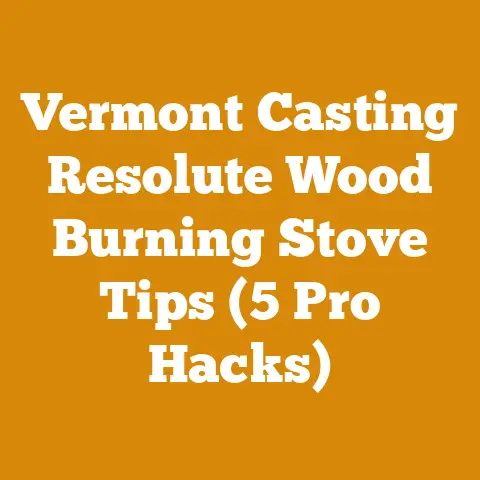How to Put Out a Flue Fire Safely (Expert Wood Heat Tips)
Ah, the smell of woodsmoke on a crisp autumn evening… few things beat it.
But that comforting aroma can quickly turn to panic if a flue fire ignites within your chimney.
I remember one particularly chilly winter when I was just starting out with my wood stove.
I’d been burning seasoned oak, diligently splitting and stacking each piece myself.
One night, a crackling fire turned into a roaring monster, and I knew something was terribly wrong.
The stovepipe was glowing red, and the sound was deafening.
That experience taught me a valuable lesson about chimney maintenance and the importance of knowing how to safely extinguish a flue fire.
How to Put Out a Flue Fire Safely (Expert Wood Heat Tips)
A flue fire, also known as a chimney fire, is a hazardous event that occurs when creosote, a flammable byproduct of burning wood, ignites inside your chimney flue.
Understanding the causes, recognizing the signs, and knowing how to respond are crucial for home safety.
Understanding Flue Fires: Causes and Dangers
Creosote buildup is the primary culprit behind flue fires.
This tar-like substance accumulates in the chimney as wood smoke cools and condenses.
Several factors contribute to creosote buildup:
- Burning unseasoned wood: Wet wood produces more smoke and, consequently, more creosote.
- Restricted air supply: Smoldering fires, often created by closing air dampers too much, lead to incomplete combustion and increased creosote production.
- Cool chimney temperatures: Cold chimney flues cause creosote to condense more readily.
- Infrequent chimney cleaning: Over time, creosote layers thicken, increasing the risk of ignition.
The dangers of a flue fire extend beyond the immediate threat of flames.
Intense heat can damage the chimney structure, potentially spreading to surrounding walls and roofing.
This can lead to structural damage, house fires, and even carbon monoxide poisoning.
According to the National Fire Protection Association (NFPA), chimney fires are a significant cause of residential fires, resulting in substantial property damage and injuries each year.
Recognizing the Warning Signs of a Flue Fire
Detecting a flue fire early can make all the difference.
Be alert for these telltale signs:
- Loud roaring or popping sounds: This is often the first indication that creosote is burning rapidly inside the chimney.
- Dense smoke and a strong, acrid odor: The smoke may be black or brown, and the smell is distinct from regular wood smoke.
- Flames or sparks shooting from the chimney: This is a clear sign of a significant fire within the flue.
- Vibrating chimney: The intense heat and burning creosote can cause the chimney to vibrate noticeably.
- Glowing or discolored stovepipe or chimney: This indicates that the metal is overheating.
If you suspect a flue fire, act immediately.
Do not hesitate to call 911, even if the fire appears small.
Step-by-Step Guide to Safely Extinguishing a Flue Fire
Safety is paramount when dealing with a flue fire.
Here’s a methodical approach to extinguishing it:
Call 911: This is always the first step.
Even if you manage to extinguish the fire yourself, the fire department can inspect the chimney for damage.-
Smother the Fire: Cut off the air supply to the fire in the firebox.
- Close the stove door tightly: Ensure the door is properly sealed.
- Close the air inlets: Shut down all air vents and dampers on the stove and stovepipe.
- Cover the front of the stove with a damp cloth: This can further reduce airflow.
Use a Class A Fire Extinguisher: If you have a Class A fire extinguisher rated for wood fires, you can carefully discharge it into the firebox.
Aim at the base of the flames.
Be prepared for a backdraft when opening the stove door.Apply Baking Soda or Salt: Pouring baking soda or salt directly onto the fire in the firebox can help smother the flames.
The chemical reaction helps to reduce the fire’s intensity.Use a Chimney Fire Extinguishing Device: There are specialized chimney fire extinguishing devices available, such as chimney fire aerosols.
These devices release a chemical agent into the flue to suppress the fire.
Follow the manufacturer’s instructions carefully.Monitor the Chimney Exterior: Check the chimney exterior for signs of heat or smoke.
Use a thermal imaging camera, if available, to identify hot spots.Evacuate if Necessary: If the fire escalates or you feel unsafe, evacuate the house immediately.
Do not re-enter until the fire department has given the all-clear.
What NOT to Do During a Flue Fire
Equally important is knowing what actions to avoid during a flue fire:
- Do not pour water down the chimney: This can cause rapid cooling and potentially crack the chimney liner or masonry.
- Do not use the fireplace or wood stove until it has been inspected: Even if you extinguish the fire, the chimney may have sustained damage that needs professional assessment.
- Do not ignore the warning signs: Prompt action is crucial to prevent the fire from escalating.
- Do not attempt to climb onto the roof: This is extremely dangerous and should be left to trained professionals.
- Do not open windows or doors: This can create drafts that fuel the fire.
Preventing Flue Fires: Essential Maintenance Tips
Prevention is always better than cure.
Regular chimney maintenance is the most effective way to prevent flue fires.
- Annual Chimney Inspections: Have your chimney professionally inspected at least once a year by a certified chimney sweep.
They can identify potential hazards and recommend necessary repairs.
The cost of a chimney inspection typically ranges from \$80 to \$500, depending on the complexity of the inspection and your location. - Regular Chimney Cleaning: Clean your chimney regularly to remove creosote buildup.
The frequency of cleaning depends on how often you use your wood stove and the type of wood you burn.
As a general rule, have your chimney cleaned if you burn more than one cord of wood per year.
Chimney cleaning costs can vary from \$125 to \$300. - Burn Seasoned Wood: Use only dry, seasoned wood.
Seasoned wood has a moisture content of less than 20%.
You can use a moisture meter to check the moisture content of your wood. - Burn Hot Fires: Burn hot fires to ensure complete combustion and minimize creosote production.
Avoid smoldering fires, which produce more smoke and creosote. - Install a Chimney Cap: A chimney cap prevents rain, snow, and debris from entering the chimney, which can contribute to creosote buildup.
A quality chimney cap can cost between \$50 and \$200.
Cost of Chimney Maintenance and Flue Fire Prevention
Maintaining a wood-burning system involves several costs, including inspections, cleaning, repairs, and fuel.
Here’s a breakdown of these costs:
- Chimney Inspection: As mentioned earlier, a professional chimney inspection costs between \$80 and \$500.
The cost varies based on the level of detail and any additional services required. - Chimney Cleaning: Regular chimney cleaning ranges from \$125 to \$300 per cleaning, depending on the chimney’s height, accessibility, and the amount of creosote buildup.
- Chimney Repairs: Chimney repairs can range from minor fixes like patching cracks (around \$100-\$500) to more extensive work such as liner replacement (\$2,500 – \$8,000) or masonry repair (\$500 – \$10,000+).
- Wood Costs: The cost of firewood varies significantly depending on location, wood type, and whether you buy it seasoned or unseasoned.
A cord of seasoned hardwood can range from \$150 to \$400 or more.
I used to get my oak for \$200 a cord, but these days, it’s closer to \$350. - Wood Moisture Meter: Essential for ensuring wood is properly seasoned.
Costs range from \$20 to \$100. - Firewood Storage: Consider the cost of building or purchasing a firewood shed or rack to keep your wood dry and organized.
Basic firewood racks can be found for around \$50, while larger sheds can cost several hundred to thousands of dollars. - Safety Equipment: Investing in fire extinguishers, smoke detectors, and carbon monoxide detectors is crucial.
A quality fire extinguisher costs between \$30 and \$100, while smoke and carbon monoxide detectors range from \$20 to \$50 each.
Budgeting for Wood Heat: A Practical Approach
Creating a budget for wood heat involves considering both upfront and ongoing costs.
Here’s a practical approach:
Assess Your Needs: Determine how much wood you’ll need for the heating season.
A general estimate is 3-5 cords of wood for a typical winter, but this varies based on your home’s size and insulation.-
Estimate Wood Costs: Research local firewood prices. Consider buying in bulk to save money.
Factor in Maintenance Costs: Allocate funds for annual chimney inspections and cleaning.
Also, budget for potential repairs.Consider DIY Options: If you’re handy, you can save money by splitting and stacking your own wood.
However, factor in the cost of tools like a chainsaw, splitting maul, and safety gear.-
Track Your Expenses: Keep a record of all wood heat-related expenses to refine your budget for future years.
Case Study: Cost Management in Firewood Preparation
Let me share a personal example.
A few years back, I decided to cut and split my own firewood to save money.
I purchased a load of tree-length logs for \$500.
Here’s how the costs broke down:
- Logs: \$500
- Chainsaw Maintenance (fuel, oil, sharpening): \$50
- Chainsaw (I already owned one, but a decent one costs \$300 – \$600)
- Splitting Maul: \$40
- Safety Gear (helmet, gloves, chaps): \$100
- Time (approximately 40 hours of labor): Priceless, but if I were paying someone, it would be around \$20/hour, totaling \$800.
In total, preparing the wood myself cost me \$690 in materials and tools, plus 40 hours of labor.
Had I bought the same amount of seasoned firewood, it would have cost me around \$1,000.
So, I saved \$310.
However, if I factored in my labor at \$20/hour, it would have been more expensive.
The key takeaway is to weigh the costs and benefits of DIY versus buying firewood.
Industry Benchmarks and Statistical Data
Understanding industry benchmarks can help you make informed decisions about wood heat.
Here are some key statistics:
- Average Price per Cord of Firewood: The average price for a cord of seasoned hardwood in the United States ranges from \$200 to \$400, according to data from local firewood suppliers and online marketplaces.
- Annual Chimney Fire Incidents: The NFPA reports that chimney fires cause approximately \$75 million in property damage annually.
- Cost of Professional Chimney Sweep Services: The average cost for a professional chimney sweep is around \$200, according to HomeAdvisor data.
- Percentage of Homes Using Wood as Primary Heat Source: Approximately 2% of homes in the United States use wood as their primary heating source, according to the U.S.
Energy Information Administration.
Practical Tips for Cost Optimization
Optimizing costs in wood processing and firewood preparation involves strategic planning and efficient practices.
- Buy Firewood in Bulk: Purchasing firewood in larger quantities can often result in lower prices per cord.
- Season Your Own Wood: Buying green wood and seasoning it yourself can save money, but requires time and storage space.
- Maintain Your Equipment: Regular maintenance of chainsaws, splitters, and other tools prolongs their lifespan and reduces repair costs.
- Negotiate Prices: Don’t be afraid to negotiate prices with firewood suppliers or loggers.
- Explore Alternative Wood Sources: Consider using fallen trees or wood from local tree trimming services.
- Invest in Efficient Wood Stoves: Modern wood stoves are more efficient and burn cleaner, reducing wood consumption.
Calculating Wood Volume: Board Feet and Cords
Understanding how to calculate wood volume is essential for buying and selling firewood.
Here are some key concepts:
- Board Foot: A board foot is a unit of measurement for lumber, equal to 144 cubic inches (e.g., 1 inch thick, 12 inches wide, and 12 inches long).
- Cord: A cord is a unit of measurement for firewood, equal to a stack of wood 4 feet high, 4 feet wide, and 8 feet long (128 cubic feet).
- Calculating Cords from Logs: To estimate the number of cords in a pile of logs, you can use online calculators or formulas based on the average diameter and length of the logs.
Estimating Wood Drying Time
Properly seasoned wood burns more efficiently and produces less creosote.
Here’s how to estimate drying time:
- Wood Species: Hardwoods like oak and maple take longer to dry than softwoods like pine and fir.
- Climate: Warm, dry climates promote faster drying.
- Stacking Method: Stacking wood in a single row with good air circulation accelerates drying.
- General Rule: Allow at least 6-12 months for hardwoods to dry properly.
Use a wood moisture meter to confirm that the moisture content is below 20%.
Challenges for Small-Scale Loggers and Firewood Suppliers
Small-scale loggers and firewood suppliers face unique challenges, including:
- Fluctuating Timber Prices: Timber prices can fluctuate based on market demand and supply.
- Equipment Costs: Chainsaws, splitters, and other equipment can be expensive to purchase and maintain.
- Labor Costs: Hiring skilled labor can be costly, especially in rural areas.
- Permitting and Regulations: Logging and firewood harvesting may be subject to permits and regulations.
- Competition: Competition from larger suppliers can make it difficult to maintain profitability.
Actionable Takeaways and Next Steps
Here are some actionable takeaways and next steps for readers planning wood processing or firewood projects:
- Schedule a Chimney Inspection: Contact a certified chimney sweep to inspect your chimney before the heating season.
- Create a Budget: Develop a budget for wood heat, including wood costs, maintenance, and safety equipment.
- Buy or Season Firewood: Purchase seasoned firewood or start seasoning your own wood.
- Invest in Safety Gear: Equip yourself with the necessary safety gear, including a fire extinguisher, smoke detectors, and carbon monoxide detectors.
- Educate Yourself: Learn about wood stove operation, chimney maintenance, and flue fire prevention.
- Maintain Your Equipment: Keep your chainsaw, splitter, and other tools in good working condition.
Final Thoughts
As I look back on that near-miss flue fire, I’m grateful for the lessons I learned.
It’s a reminder that wood heat, while comforting and efficient, requires vigilance and respect.
By understanding the risks, taking preventative measures, and being prepared to respond, you can enjoy the warmth of wood heat safely and economically.
Remember, a well-maintained wood-burning system not only saves you money but also protects your home and family.






